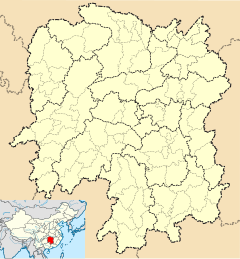Liuzi Temple (simplified Chinese: 柳子庙; traditional Chinese: 柳子廟; pinyin: Liǔzǐmiào) is a monument built to honor Liu Zongyuan, a Chinese writer and poet who lived there for 10 years during the Tang dynasty (618–907).[1][2][3][4][5] The temple covers more than 2,000-square-metre (22,000 sq ft) and is made of wood and brick.[6] It is located in Yongzhou, Hunan, beside Yu Stream (愚溪)
| Liuzi Temple | |
|---|---|
柳子庙 | |
 The entrance. | |
| Religion | |
| Sect | Confucianism |
| Location | |
| Location | Lingling District, Yongzhou, Hunan |
| Country | China |
| Geographic coordinates | 26°13′16″N 111°36′12″E / 26.22112°N 111.60325°E |
| Architecture | |
| Date established | AD 1056 |
History
editLiuzi Temple is a Confucian temple with a history of nearly a thousand years. It was built as Liu Zihou Ancestral Temple (柳子厚祠堂) in the 3rd Year of Period Zhihe, AD 1056, in the reign of Emperor Renzong in the Northern Song dynasty (960–1127).[6][7]
The temple was reconstructed in the 14th Year of Period Shixing (1144) in the Southern Song dynasty (1127-1279).[citation needed]
The temple was repaired twice during the Ming dynasty (1368–1644); first in the 8th Year of Zhengde Emperor (1513), and then in the 25th Year of Jiajing Emperor (1546).[6]
Liuzi Temple was repaired on a large scale in the 3rd Year of Guangxu Emperor (1877) of Qing dynasty (1644–1911).[citation needed]
In 1957 the temple was designated as a provincial level key cultural heritage. In 1963, Tao Zhu, secretary of Bureau of the Central Southern China of the Chinese Communist Party, visited the temple and gave an instruction to protect the temple. He said: "(We) should strengthen attention and protection of the Liuzi Temple, (we) need to raise funds to restore the Liuzi Temple as soon as possible" (要加强对柳子庙的重视和保护,筹集资金尽快加速对柳子庙的重修工作。). On June 25, 2001, it was listed among the fifth group of "State Cultural Protection Relics Units" by the State Council of China.[6]
Architecture
editLiuzi Temple has three halls: the main hall (in front), the middle hall and the back hall.
Gate and stage
editThe gate is built in a row with a big one in the middle and a small one on each side, just like the shanmen in Han Chinese Buddhist Temples. On each side of the main entrance is a Chinese guardian lion. A couplet hanging on the two sides of the doorway reads "山水来归,黄蕉丹荔;春秋报事,福我寿民。". The couplet was written by magistrate of Yongzhou Yang Han (杨翰) in the Period of Tongzhi Emperor of Qing Dynasty. A double eave and eight columns stage behind the main hall, which was used for worshiping Liu Zongyuan. The stage was renovated in 1957. A plaque written by He Shaoji is on the stage. It reads "山水绿" (meaning "green landscape") in Chinese.[6]
Steles
editLiuzi Temple has many Steles, such as Lizi Stele (荔子碑), Song of Catching Snakes (捕蛇歌), and Looking for Yu Stream and Visiting Liuzi Temple (寻愚溪谒柳子庙).
Lizi Stele
editLizi Stele, also known as Sanjue Stele (三绝碑; Sanjue, means "three wonders"). Its article content was written by Han Yu and was in Su Shi's handwriting. The Lizi Stele (originally collected in Liuhou Ancestral Temple (柳侯祠), Liuzhou. Liu Keqin (刘克勤)) was copied by a local official and later was destroyed. The modern stele was carved in the 7th Year of Tongzhi Emperor (1868) of Qing Dynasty.[6]
References
edit- ^ 华文媒体采访团走进永州柳子庙 追寻柳宗元足迹. sohu (in Chinese). 2013-07-10.
- ^ 永州柳子庙修缮将收尾五一有望开放. sina (in Chinese). 2015-04-29.
- ^ 永州零陵区委书记严兴德调研柳子庙修缮工程(组图). 163.com (in Chinese). 2015-05-04.
- ^ Yaohong, Huang (2015-04-08). 为山水立心——谒柳子庙. ifeng (in Chinese).
- ^ 图:百余名中外文人湖南柳子庙公祭柳宗元. 163.com (in Chinese). 2010-10-02.
- ^ a b c d e f Peng Wei (2016-11-15). 首届湖南文物解读大赛 千年斯文第,绝贯古今人. rednet.cn (in Chinese).
- ^ "30 historic and cultural neighborhoods to visit in China". Chinadaily. 2015-08-06.

